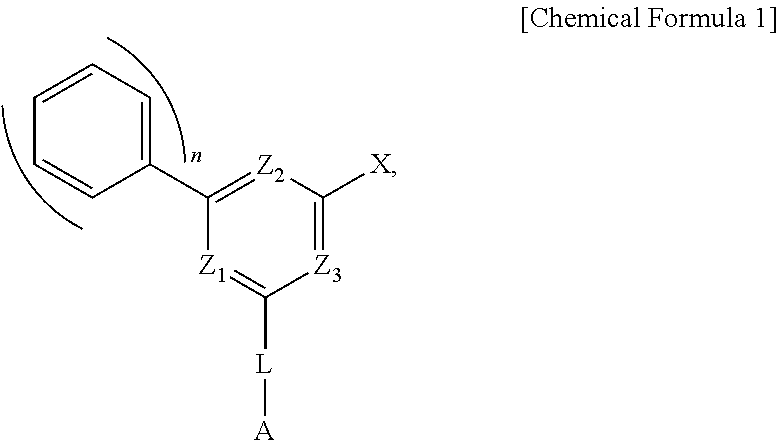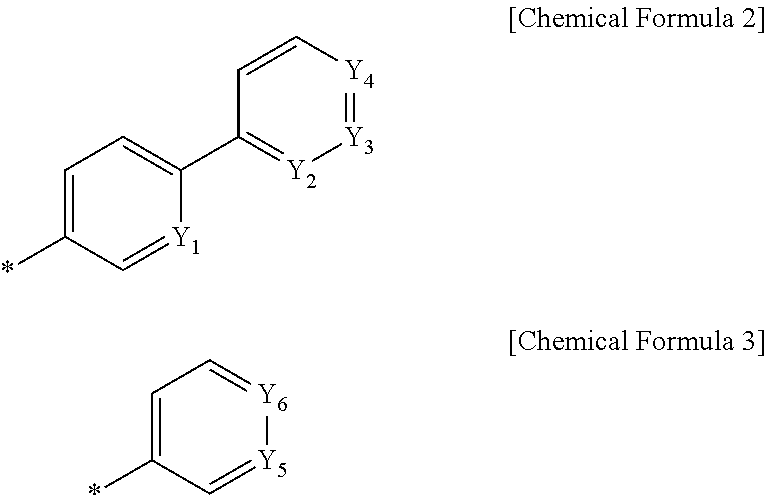Organic light-emitting compound and organic electroluminescent device using the same
a technology of organic light-emitting compound and organic electroluminescent device, which is applied in the direction of luminescent compositions, organic chemistry, chemistry apparatus and processes, etc., can solve the problems of poor thermal stability, unsatisfactory current efficiency and lifespan characteristics of organic el devices in which such conventional materials are used in the organic layer, etc., to improve light-emitting performance, driving voltage, efficiency, and efficiency.
- Summary
- Abstract
- Description
- Claims
- Application Information
AI Technical Summary
Benefits of technology
Problems solved by technology
Method used
Image
Examples
preparation example 1
[Preparation Example 1] Synthesis of PPY-1
Synthesis of PPY-1
[0070]
[0071]45.0 g of 4,6-dichloro-2-phenylpyrimidine and 40.0 g of (4-(pyridin-3-yl)phenyl)boronic acid, 6.0 g of tetrakis(phenylphosphine)palladium (0), and 42 g of K2CO3 were added to 800 ml of toluene, 200 ml of ethanol, and 200 ml of water, and the mixture was stirred and heated under reflux for 2 hours. After the reaction was completed, the solution was inactivated with a sufficient amount of water, and transferred to a separatory funnel, followed by extraction with methylene chloride. An organic layer was dried over magnesium sulfate, concentrated and purified by column chromatography, thereby obtaining 39.8 g (yield 58%) of PPY-1.
[0072]1H-NMR: δ 9.24 (s, 1H), 8.70 (d, 1H), 8.42-8.30 (m, 5H), 7.57-7.50 (m, 4H), 7.25 (d, 2H) 7.03 (s, 1H)
[0073]Mass: [(M+H)+]: 344
preparation example 21
[Preparation Example 21 Synthesis of PPY-2 and 3
Synthesis of (E)-1-(4-bromophenyl)-3-(4-pyridin-3-yl)phenyl)prop-2-ene-1-one
[0074]
[0075]50.0 g of 4-(pyridin-3-yl) benzaldehyde, 49.1 g of 1-(4-bromophenyl)ethan-1-one, and 18.2 g of sodium methoxide were added to 800 ml of ethanol, and the mixture was stirred for 8 hours. After the reaction was completed, the mixture was stirred at room temperature for 1 hour, followed by extraction with ethyl acetate. An organic layer was dried over magnesium sulfate, concentrated and purified by column chromatography, thereby obtaining 36.4 g (yield 72%) of (E)-1-(4-bromophenyl)-3-(4-pyridin-3-yl)phenyl)prop-2-ene-1-one.
[0076]1H-NMR: δ 9.24 (s, 1H), 8.50 (d, 1H), 8.38 (d, 1H), 8.08-8.01 (m, 3H), 7.75 (d, 2H), 7.60-7.45 (m, 6H)
[0077]Mass: [(M+H)+]: 364
Synthesis of PPY-2
[0078]
[0079]36.4 g of (E)-1-(4-bromophenyl)-3-(4-pyridin-3-yl)phenyl)prop-2-ene-1-one, 24.1 g of benzimidamide hydrochloride, 14.2 g of sodium hydroxide were added to 500 ml of ethan...
preparation example 3
[Preparation Example 3] Synthesis of PPY-4 to 6
Synthesis of (E)-1-(3-bromophenyl)-3-(4-pyridin-3-yl)phenyl)prop-2-ene-1-one
[0086]
[0087]50.0 g of 4-(pyridin-3-yl) benzaldehyde, 49.1 g of 1-(3-bromophenyl)ethan-1-one, and 18.2 g of sodium methoxide were added to 800 ml of ethanol, and the mixture was stirred for 8 hours. After the reaction was completed, the mixture was stirred at room temperature for 1 hour, followed by extraction with ethyl acetate. An organic layer was dried over magnesium sulfate, concentrated and purified by column chromatography, thereby obtaining 38.2 g (yield 74%) of (E)-1-(3-bromophenyl)-3-(4-pyridin-3-yl)phenyl)prop-2-ene-1-one.
[0088]1H-NMR: δ 9.24 (s, 1H), 8.50 (d, 1H), 8.38 (d, 1H), 8.08-8.01 (m, 3H), 7.82 (d, 1H), 7.60-7.45 (m, 7H)
[0089]Mass: [(M+H)+]: 364
Synthesis of PPY-4
[0090]
[0091]38.2 g of (E)-1-(3-bromophenyl)-3-(4-pyridin-3-yl)phenyl)prop-2-ene-1-one, 25.0 g of benzimidamide hydrochloride, and 14.8 g of sodium hydroxide were added to 500 ml of et...
PUM
| Property | Measurement | Unit |
|---|---|---|
| current density | aaaaa | aaaaa |
| Chemical Formula | aaaaa | aaaaa |
| structures | aaaaa | aaaaa |
Abstract
Description
Claims
Application Information
 Login to View More
Login to View More - R&D
- Intellectual Property
- Life Sciences
- Materials
- Tech Scout
- Unparalleled Data Quality
- Higher Quality Content
- 60% Fewer Hallucinations
Browse by: Latest US Patents, China's latest patents, Technical Efficacy Thesaurus, Application Domain, Technology Topic, Popular Technical Reports.
© 2025 PatSnap. All rights reserved.Legal|Privacy policy|Modern Slavery Act Transparency Statement|Sitemap|About US| Contact US: help@patsnap.com



